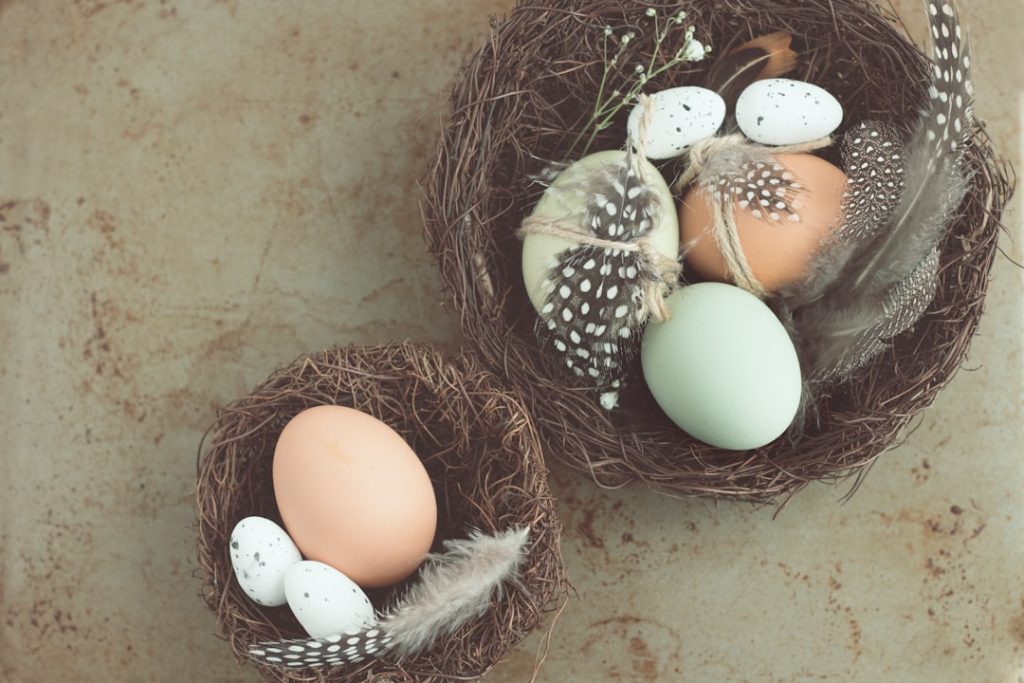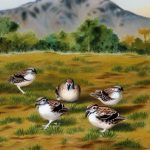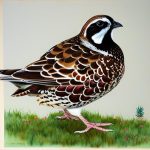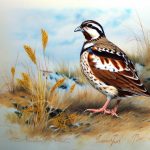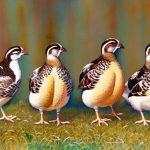Bobwhite quail, also known as northern bobwhite, is a popular game bird native to North America. These small, ground-dwelling birds are known for their distinctive “bob-white” call, which is often heard in the early morning and late evening. Bobwhite quail are highly valued for their delicious meat and are also popular among hunters for their challenging and exciting hunting experience. In addition to their popularity as game birds, bobwhite quail are also commonly raised for breeding and release into the wild for conservation purposes. These birds are known for their hardiness and adaptability, making them a popular choice for both hobbyists and commercial breeders.
Bobwhite quail are known for their social nature and are often found in coveys, which are small groups of birds that forage and roost together. They are ground-nesting birds and typically lay their eggs in a shallow depression lined with grass and other vegetation. The female bobwhite quail is responsible for incubating the eggs and caring for the chicks once they hatch. These birds are known for their rapid growth and can reach reproductive maturity at a relatively young age, making them an attractive option for breeders looking to establish a breeding program.
Table of Contents
- 1 Reproductive Maturity in Bobwhite Quail
- 2 Factors Affecting Breeding Age
- 3 Breeding Age for Bobwhite Quail
- 4 Breeding Practices for Bobwhite Quail
- 5 Health Considerations for Breeding Bobwhite Quail
- 6 Conclusion and Future Considerations
- 7 FAQs
- 7.1 What is the breeding age for bobwhite quail?
- 7.2 At what age do bobwhite quail reach sexual maturity?
- 7.3 How can you determine the breeding age of bobwhite quail?
- 7.4 What factors can affect the breeding age of bobwhite quail?
- 7.5 Are there any health considerations when breeding bobwhite quail at a young age?
Key Takeaways
- Bobwhite quail are small ground-dwelling birds native to North America, known for their distinctive “bob-white” call.
- Bobwhite quail reach reproductive maturity at around 16-20 weeks of age, with females typically maturing earlier than males.
- Factors affecting breeding age in bobwhite quail include genetics, nutrition, and environmental conditions.
- The ideal breeding age for bobwhite quail is around 6-8 months, when they are fully mature and in peak reproductive condition.
- Breeding practices for bobwhite quail should include providing proper nesting materials, monitoring breeding pairs, and ensuring a balanced diet to support healthy reproduction.
Reproductive Maturity in Bobwhite Quail
Reproductive maturity in bobwhite quail is reached at a relatively young age compared to other bird species. Typically, male bobwhite quail reach sexual maturity at around 3-4 months of age, while females reach maturity at around 4-5 months of age. This early maturity is one of the reasons why bobwhite quail are popular among breeders, as it allows for a relatively quick turnaround in breeding and production. Once they reach sexual maturity, bobwhite quail are capable of breeding throughout the breeding season, which typically occurs in the spring and summer months.
When it comes to breeding, male bobwhite quail are known for their elaborate courtship displays, which involve puffing up their feathers, strutting, and calling out to attract females. Once a pair has formed, the female will lay a clutch of eggs in a shallow nest on the ground, typically laying one egg per day until the clutch is complete. The eggs are then incubated by the female for around 23-24 days before hatching. Once the chicks hatch, they are precocial, meaning they are able to leave the nest and feed themselves shortly after hatching. This rapid development and early maturity make bobwhite quail an attractive option for breeders looking to establish a breeding program.
Factors Affecting Breeding Age
Several factors can affect the breeding age of bobwhite quail, including genetics, nutrition, environmental conditions, and social factors. Genetics play a significant role in determining the age at which bobwhite quail reach sexual maturity, with some lines of birds reaching maturity earlier than others. Nutrition also plays a crucial role in the development and reproductive maturity of bobwhite quail, as a well-balanced diet is essential for healthy growth and development. Environmental conditions, such as temperature and photoperiod, can also influence the timing of sexual maturity in bobwhite quail, with longer daylight hours typically triggering the onset of breeding behavior.
Social factors can also play a role in the breeding age of bobwhite quail, as the presence of other mature birds can influence the timing of sexual maturity in younger birds. In some cases, the presence of older, more dominant birds can delay the onset of breeding behavior in younger birds. Conversely, the absence of mature birds can sometimes accelerate the onset of breeding behavior in younger birds. Understanding these factors and how they interact can help breeders optimize their breeding programs and maximize reproductive success.
Breeding Age for Bobwhite Quail
The breeding age for bobwhite quail can vary depending on a variety of factors, but in general, male bobwhite quail reach sexual maturity at around 3-4 months of age, while females reach maturity at around 4-5 months of age. However, it’s essential to note that individual birds within a population may reach sexual maturity at slightly different ages due to genetic variation and environmental influences. Breeders should closely monitor their birds to determine the optimal age for breeding based on the specific characteristics of their flock.
It’s also important to consider the overall health and well-being of the birds when determining the breeding age for bobwhite quail. Birds that are not in optimal health may not reach sexual maturity at the expected age or may have reduced reproductive success. Providing a well-balanced diet, appropriate housing, and regular veterinary care can help ensure that bobwhite quail reach sexual maturity at the appropriate age and are able to successfully breed and produce healthy offspring.
Breeding Practices for Bobwhite Quail
Breeding practices for bobwhite quail typically involve selecting healthy, mature birds for breeding and providing them with appropriate housing and nesting materials. It’s essential to provide a well-balanced diet that meets the nutritional needs of breeding birds to ensure optimal reproductive success. Breeders should also carefully monitor their birds for signs of stress or illness and provide appropriate veterinary care as needed.
When it comes to breeding, it’s important to provide suitable nesting sites and materials for the female bobwhite quail to lay her eggs. Nesting boxes or shelters with soft bedding materials can provide a safe and comfortable environment for the female to lay her eggs and care for her chicks. Once the eggs have been laid, it’s important to monitor the nesting site closely to ensure that the eggs are being properly incubated and that the chicks have a safe environment in which to hatch and grow.
In some cases, breeders may choose to artificially incubate bobwhite quail eggs to maximize reproductive success. This involves carefully monitoring temperature and humidity levels to ensure optimal conditions for egg development. Artificial incubation can be a useful tool for breeders looking to maximize egg production and hatch rates.
Health Considerations for Breeding Bobwhite Quail

Maintaining the health of breeding bobwhite quail is essential for ensuring reproductive success and producing healthy offspring. Providing a well-balanced diet that meets the nutritional needs of breeding birds is crucial for maintaining optimal health and reproductive function. It’s important to provide access to clean water at all times and monitor birds for signs of illness or stress.
Regular veterinary care is also essential for maintaining the health of breeding bobwhite quail. Routine check-ups can help identify and address any health issues before they impact reproductive success. Additionally, providing appropriate housing and nesting materials can help reduce stress and provide a safe environment for breeding birds.
Breeders should also be mindful of potential disease risks when managing their breeding flock. Implementing biosecurity measures can help prevent the spread of disease and protect the health of breeding birds. It’s important to quarantine new birds before introducing them to an existing flock and to regularly clean and disinfect housing facilities to minimize disease transmission.
Conclusion and Future Considerations
In conclusion, bobwhite quail are popular game birds known for their early reproductive maturity and rapid growth. Understanding the factors that influence breeding age and implementing appropriate breeding practices are essential for maximizing reproductive success and producing healthy offspring. Maintaining the health of breeding bobwhite quail through proper nutrition, housing, and veterinary care is crucial for ensuring optimal reproductive function.
Looking ahead, future considerations for breeding bobwhite quail may include further research into genetic factors influencing reproductive maturity, as well as continued efforts to optimize breeding practices for maximum reproductive success. Additionally, ongoing efforts to monitor and address potential health risks will be essential for maintaining the overall health and well-being of breeding bobwhite quail populations. By staying informed about best practices and remaining attentive to the specific needs of their flock, breeders can continue to enjoy successful breeding programs and contribute to the conservation and enjoyment of these beloved game birds.
If you’re interested in learning more about the breeding age of bobwhite quail, you might also find our article on how many eggs geese lay to be informative. Understanding the reproductive patterns of different poultry species can provide valuable insights for breeders and enthusiasts alike.
FAQs
What is the breeding age for bobwhite quail?
The breeding age for bobwhite quail is typically around 16 to 20 weeks old.
At what age do bobwhite quail reach sexual maturity?
Bobwhite quail reach sexual maturity at around 16 to 20 weeks of age.
How can you determine the breeding age of bobwhite quail?
You can determine the breeding age of bobwhite quail by observing their physical characteristics and behavior, such as the development of their plumage and their mating behavior.
What factors can affect the breeding age of bobwhite quail?
Factors such as diet, environmental conditions, and genetics can affect the breeding age of bobwhite quail.
Are there any health considerations when breeding bobwhite quail at a young age?
Breeding bobwhite quail at a young age can potentially lead to health issues, such as reproductive problems and stunted growth. It is important to ensure that the quail are in good health before breeding them.
Meet Walter, the feathered-friend fanatic of Florida! Nestled in the sunshine state, Walter struts through life with his feathered companions, clucking his way to happiness. With a coop that’s fancier than a five-star hotel, he’s the Don Juan of the chicken world. When he’s not teaching his hens to do the cha-cha, you’ll find him in a heated debate with his prized rooster, Sir Clucks-a-Lot. Walter’s poultry passion is no yolk; he’s the sunny-side-up guy you never knew you needed in your flock of friends!

